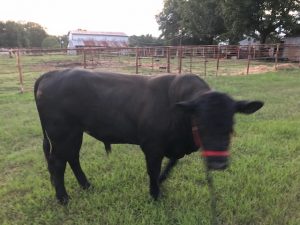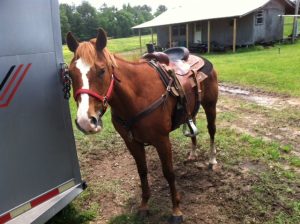I believe it was July of 2011 when I came home from work one afternoon to discover my 10-year-old stepson, Dawson, had convinced his grandparents to let him pen a heifer to show in the county fair.
She was a pretty little 1-year-old heifer, peach colored with a white face. Since she was the color of peaches and cream, we called her Peaches.
Dawson was super excited about her and could not be deterred from wanting to show her. We all explained that it was much too late in the year for training a show cow. With the county fair just two months away, there was simply no way she could possibly be ready to show by September. If he wanted to show her we should have started working with her way back in January or February.
Dawson’s enthusiasm remained steadfast. He was convinced he could have her ready and was determined to show her at the fair.
So, I determined to help him all I could.
Every day, he and I spent time with Peaches, getting her used to us. We got her to eat out of our hands and let us pet her. We taught her to stand tied without too much fuss. We made a lot of progress with her, but we never did get her to halter lead.
I spent many hours in the pen with Peaches on a calf halter, trying to lead her. The more I pulled the more she resisted. She just locked up and refused to budge.
I tried pulling to the side so she had less balance to resist. She would take one step to the side and go right back into lock-up resistance mode.
We talked to friends who raised show cows asking for advice. The prevailing advice was to teach her that resistance was futile. She had to learn that following was her only option. They advised hooking her to a tractor and pulling her very slowly to teach her to stop resisting and follow the lead.
So, we did that. I spent many hours slowly driving the tractor around in circles pulling peaches one resistant step after another. She actually got to where she would half-way follow the tractor, but only with substantial tension in the rope. With me trying to lead on the ground, she was more resistant than ever.
With final fair entry dates rapidly approaching, Peaches was no closer to being halter trained than the day we started. We did the only thing we could do…we turned Peaches back out in the pasture with the other cows.
I honestly think I took it harder than Dawson did. Even though I knew it had been an impossible task from the start, I had gone all-in trying to help him train her, and had failed.
Fast forward to June of 2018…
Sherri’s parents had penned a nice looking 2-year-old bull to keep the older (much larger) bulls from injuring him before he got big enough to protect himself. With Dad recuperating from surgery I started feeding the bull twice daily.
The bull was super skittish. When I entered the pen, he fled to the other end. When I poured his feed, he watched until I left the pen before approaching to eat. When I tried approaching to pet him while he ate, he fled before I came within two feet.
In July, the bull became covered up with flies, constantly swishing his tail and tossing his head trying to halt their torment. The poor guy looked absolutely miserable and became even more unapproachable.
I started planning a means of helping him get some relief from the flies. The best approach would be to fly-spray him, but that would require getting him to stand still long enough to be sprayed.
The last couple of years I’ve been learning a little about horsemanship and I decided to try desensitizing the bull to a spray bottle just as I would a horse. I filled a spray bottle with water, walked up as close as he would allow, turned my back to him and started squirting water away from him. He was disturbed and started moving away, so I moved with him, still facing away and still squirting water. When he stopped, I stopped squirting. After a few minutes, he would stand still while I squirted water away from him.
Then I started squirting in an arc that got water closer to him, while still facing away from him, and we repeated the same thing until he accepted that. Then I turned to face him and did the same thing all over again.
At the end of about twenty minutes, he would stand still for spraying. So I switched bottles and fly-sprayed.
With relief from the flies, he became a much calmer bull. A few days later he let me pet him while he ate. A couple of weeks later he started coming to me for treats. By the end of the month, he was positively friendly.
I started calling him Ferdinand (after the gentle bull in the children’s story) and bought a halter for him. Using the same pressure and release technique I would use on a horse, I had him following a lead line pretty quickly. By rewarding the smallest try with instant release, Ferdinand quickly learned what I wanted and followed willingly.
I wouldn’t call him completely halter broke yet, but he leads really well and backs okay when not too distracted. He and I are having a lot of fun, together!
I keep thinking about these two experiences with cattle training and their completely different outcomes.
With Peaches, I set out specifically to halter train her, spent many hours working with her, and completely failed. With Ferdinand, I just tried to gain his trust to help alleviate his fly misery…and almost effortlessly halter trained him in just a few minutes a day.
Two drastically different outcomes…based on different approaches.
With Peaches, I set out to make her learn. We had a very tight time table and needed to progress rapidly. I viewed her as being stubborn and acted accordingly trying to show her resistance was futile. It was a fast-paced conquer-by-force approach that did not work well at all.
With Ferdinand, I set out to gain his trust in order to help him. I used timing of pressure and release to teach him a little at a time, only giving him as much as he was prepared to accept…and it worked incredibly well.
Isn’t it the same way with people? We set out to make somebody do something or to prove somebody wrong and our headstrong approach is met with nothing but resistance. If we, instead, set out to gain someone’s trust in order to help them see things a little differently, we may see drastically improved results.
I’m sure glad God uses a gentle approach with us!
“Come to Me, all who are weary and heavy-laden, and I will give you rest. Take My yoke upon you and learn from Me, for I am gentle and humble in heart, and you will find rest for your souls. For My yoke is easy and My burden is light.” (Matthew 11:28-30)
P.S. Oh…about Peaches… Peaches is still part of the herd and is a good mama-cow. All that time spent with her was not wasted. She is the calmest, gentlest cow in the herd. Lately, I’ve been using her to help train my horse, Knockout, to move cattle. She is super easy to guide from one end of the pasture to the other. She makes Knockout and me look really good, providing good practice and confidence building.
Your thoughts?


